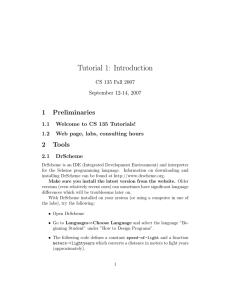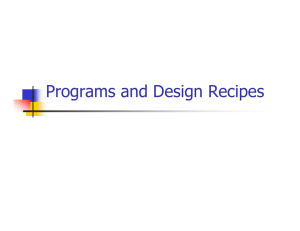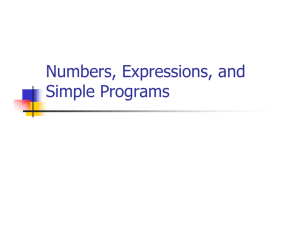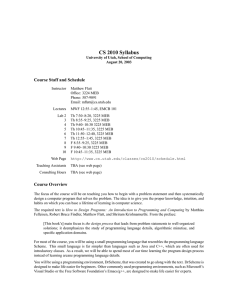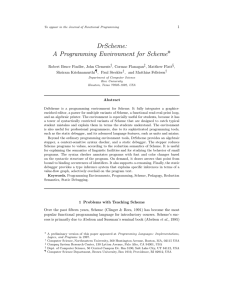The DrScheme Project: An Overview
advertisement
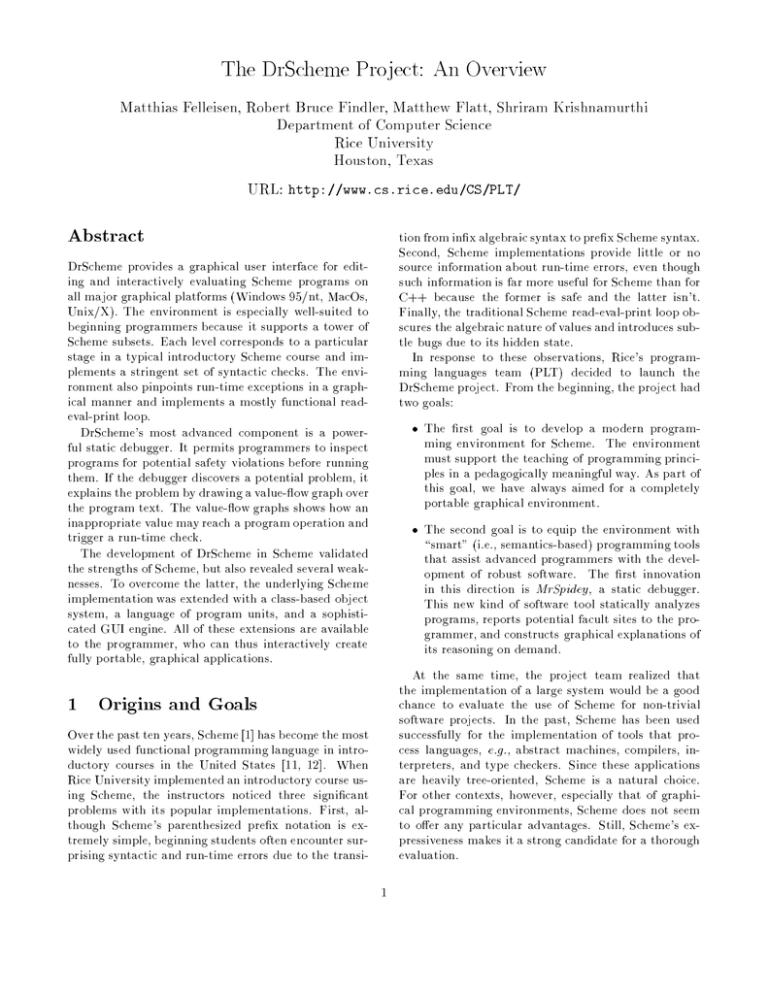
The DrScheme Project: An Overview
Matthias Felleisen, Robert Bruce Findler, Matthew Flatt, Shriram Krishnamurthi
Department of Computer Science
Rice University
Houston, Texas
URL: http://www.cs.rice.edu/CS/PLT/
Abstract
tion from inx algebraic syntax to prex Scheme syntax.
Second, Scheme implementations provide little or no
source information about run-time errors, even though
such information is far more useful for Scheme than for
C++ because the former is safe and the latter isn't.
Finally, the traditional Scheme read-eval-print loop obscures the algebraic nature of values and introduces subtle bugs due to its hidden state.
In response to these observations, Rice's programming languages team (PLT) decided to launch the
DrScheme project. From the beginning, the project had
two goals:
The rst goal is to develop a modern programming environment for Scheme. The environment
must support the teaching of programming principles in a pedagogically meaningful way. As part of
this goal, we have always aimed for a completely
portable graphical environment.
The second goal is to equip the environment with
\smart" (i.e., semantics-based) programming tools
that assist advanced programmers with the development of robust software. The rst innovation
in this direction is MrSpidey , a static debugger.
This new kind of software tool statically analyzes
programs, reports potential facult sites to the programmer, and constructs graphical explanations of
its reasoning on demand.
At the same time, the project team realized that
the implementation of a large system would be a good
chance to evaluate the use of Scheme for non-trivial
software projects. In the past, Scheme has been used
successfully for the implementation of tools that process languages, e.g., abstract machines, compilers, interpreters, and type checkers. Since these applications
are heavily tree-oriented, Scheme is a natural choice.
For other contexts, however, especially that of graphical programming environments, Scheme does not seem
to oer any particular advantages. Still, Scheme's expressiveness makes it a strong candidate for a thorough
evaluation.
DrScheme provides a graphical user interface for editing and interactively evaluating Scheme programs on
all major graphical platforms (Windows 95/nt, MacOs,
Unix/X). The environment is especially well-suited to
beginning programmers because it supports a tower of
Scheme subsets. Each level corresponds to a particular
stage in a typical introductory Scheme course and implements a stringent set of syntactic checks. The environment also pinpoints run-time exceptions in a graphical manner and implements a mostly functional readeval-print loop.
DrScheme's most advanced component is a powerful static debugger. It permits programmers to inspect
programs for potential safety violations before running
them. If the debugger discovers a potential problem, it
explains the problem by drawing a value-ow graph over
the program text. The value-ow graphs shows how an
inappropriate value may reach a program operation and
trigger a run-time check.
The development of DrScheme in Scheme validated
the strengths of Scheme, but also revealed several weaknesses. To overcome the latter, the underlying Scheme
implementation was extended with a class-based object
system, a language of program units, and a sophisticated GUI engine. All of these extensions are available
to the programmer, who can thus interactively create
fully portable, graphical applications.
1 Origins and Goals
Over the past ten years, Scheme [1] has become the most
widely used functional programming language in introductory courses in the United States [11, 12]. When
Rice University implemented an introductory course using Scheme, the instructors noticed three signicant
problems with its popular implementations. First, although Scheme's parenthesized prex notation is extremely simple, beginning students often encounter surprising syntactic and run-time errors due to the transi1
has lapsed into algebraic syntax in the second clause
of the cond-expression. Since in standard Scheme the
value of a cond-clause is the value of its last expression, this version of length always returns 0, regardless
of its input. Other lapses into algebraic syntax may
yield similarly inexplicable results or, even worse, error
messages from the run-time system that make no sense
for a beginning student.
In DrScheme, beginners are protected from such
mishaps. By choosing the language level \Beginner", a
programmer installs a stringent set of syntactic checks,
which recognizes lapses into algebraic notation as easily
explicable syntax mistakes. A beginner can then x
these mistakes before they cause additional run-time
problems. The other language levels (\Intermediate",
\Advanced", and \QuasiR4RS") address similar, but
less severe problems with Scheme's syntax.
Finally, the project naturally yields a signicant body
of Scheme code that is used on a daily basis. The examples and impetus provided by working with large programs are invaluable in improving the environment and
its smart tools. The eventual goal is to produce a selfapplicable programming environment and to prove the
usefulness of the smart tools in this context.
This column primarily addresses the rst set of goals.
It presents DrScheme and MrSpidey and explains how
these tools support teaching and programming. qTwo
short sections briey discuss the remaining two goals.
The reference section provides some pointers for complementary reports on the project and its contributions.
2 DrScheme: The Environment
DrScheme integrates program editing and program evaluation in a seamless manner (see gure 1). To overcome the problems of traditional Scheme implementations, its editor and evaluator support: a hierarchy
of four Scheme subsets whose choice is pedagogically
motivated, source correlation at all execution steps,
and a new kind of read-eval-print loop. In addition,
DrScheme also oers two pedagogic tools: a symbolic
evaluator and a context-sensitive syntax checker. Finally, DrScheme includes a static debugger, which analyzes programs and exposes potential safety violations
prior to execution. The following three subsections provide an overview of DrScheme; for more detailed information, we refer the reader to an extended report [5].
Run-Time Errors: Many modern Pascal and C++
environments highlight a source location when a program causes a core dump. Unfortunately, this source
correlation is in general completely useless because the
corresponding segmentation fault or bus error is not
a direct consequence of the abuse of a computational
primitive. The primitive has been misapplied much earlier, but since low-level languages do not enforce abstraction invariants between the computer architecture
and the programming language, nonsensical bit patterns
may ow through the program arbitrarily long before an
error is signaled, if at all.
Scheme and other functional languages are safe and
through a mixture of syntatic and run-time checks enforce invariants and, in turn, the intended level of data
abstraction. More technically, each primitive operation
(for which it is not possible to enforce its invariants statically) checks at run-time whether or not its arguments
and results are in the proper range. Examples of operations that check their arguments at run-time are arithmetic operations, array indexing, and \pointer" dereferencing. When an operation detects a problem with its
arguments or results, it aborts the program execution.
Unfortunately, conventional Scheme environments do
not connect such run-time errors with the corresponding source location and thus force the programmer to
search through the program for the error.
In contrast, in DrScheme a failed safety check does
not only signal the nature of an error but also highlights its location in the program. To implement the
second part, the underlying Scheme parser keeps track
of source locations even across general macro expansions [3, 10]. The evaluator uses this source information,
if desired, by setting a special \source register" ahead
of primitive computational steps. This source register
contains enough information to highlight the primitive
application if it fails. The strategy ensures source cor-
2.1 Pedagogic Enhancements
Language Levels: University courses typically intro-
duce students to Scheme in discrete segments. The rst
segment covers rst-order functional programming, the
second one higher-order functions and data structuring, and the third one imperative facilities like set!,
operations that mutate data, and call/cc. Given this
widespread practice, DrScheme permits users to choose
one of these levels and then strictly enforces correspondingly restrictive syntactic rules.
The strict enforcement of syntactic rules solves numerous notational problems for beginners who, through
school mathematics and high school programming
courses, have become used to inx operators and operator precedence. For example, the author of the program
(dene (length l )
(cond
[(null? l ) 0]
[else 1 + (length (rest l ))]))
2
Figure 1: The DrScheme Window (Windows 95/NT version)
relation and preserves the desired tail-call optimization
of Scheme [1].
data mutation, it exposes the sharing among nodes in
a value. For exibility, the user can change the printer
that is provided by default. The choices also include
the traditional Scheme printer, and a printer that supports both program-writing programs and an algebraic
understanding of program execution (via quasiquote).
The namespace parameterization enables the environment to start each program execution with a clean slate.
That is, every time the programmer clicks on the \Execute" button (see gure 1), the Repl loads the current
set of denitions into a new namespace, which eliminates all legacy denitions from the preceding series of
interactions. The environment thus eciently mimics
an inecient and error-prone technique that is used by
experienced Scheme programmers to avoid legacy problems.
A Transparent Repl: One distinct advantage of
Scheme over conventional languages is its read-evalprint loop (Repl). Using the Repl, students can easily
experiment with individual expressions, procedures, or
compilation units. They can also change a program during execution to x a bug on the y or to observe and
measure certain quantities. While the Repl is an excellent tool for gentle introductions to computing, it often
causes subtle bugs in the various stages of an introductory course.
The traditional Repl interferes with teaching in two
ways. First, Scheme's Repl inherited the LISP printer,
which displays results in a list-oriented notation that
ressembles but is not identical to the input notation.
Although this form of printing is useful for experienced
programmers, especially in the context of programwriting programs, it is unintuitive for beginners who
learn to compute the value of a Scheme program using ordinary algebra. Second, a Repl uses a modiable table, the namespace , to keep track of denitions.
Consequently, the Repl is a state-oriented element in a
world that otherwise has the appearances of an implementation of algebra. If the Repl is used in a careless
manner, it can introduce or shadow program bugs in a
way that is utterly confusing to beginning students.
DrScheme overcomes both problems with a new
Repl, which diers from Scheme's traditional read-evalprint loop in that it is parameterized over the printer
and the namespace of the evaluator. The printer parameterization permits matching the language level and
the printer. Thus, for a beginner, DrScheme prints the
algebraic form of a value. After the introduction of
2.2 Pedagogic Tools
The Symbolic Stepper: Scheme courses invariably
introduce Scheme's basic functional core via a reduction
semantics. The semantics extends three groups of algebraic laws that students are (or should be) intimately
familiar with: the laws of primitive operations (like addition); the law of function application (v -reduction);
and the law of replacement of equals by equals. This
reduction semantics scales up to full Scheme [4]
DrScheme includes a tool that enables students to reduce a program to a value, step by step. It can deal with
all the features used in Rice University's course, including the entire functional sub-language, structure denitions, variable assignment, data structure mutation,
exceptions, and other control mechanisms. A student
invokes the stepper on the current program by choos3
Figure 2: MrSpidey: The static debugger (X version)
ables, and constants. On demand, the syntax checker
also displays arrows that point from bound identiers
to their binding occurrence, and from binding identiers to all of the their bound occurrences. Since the
checker processes the lexical structure of the program,
a program can use it to -rename bound and dened
identiers.
ing ToolsjStepper.1 By default, the stepper shows every
reduction step of a program evaluation. While this default is useful for a complete novice, a full reduction sequence contains too much information for programmers
with some experience. Hence the stepper permits the
student to choose which reduction steps are shown or
which sub-expressions the stepper is to focus on. The
student can change these controls to view a more detailed reduction sequence at each stop.
Students use the stepper for two purposes. First, they
use it to understand the meaning of new language features as they are introduced in the course. A few sessions with the stepper illustrates the behavior of new
language constructs better than any blackboard explanation. Second, students use the stepper to nd bugs in
small programs. The stepper stops when it encounters a
run-time error and permits students to move backwards
through the reduction sequence. This usage quickly explains the reasons for bugs and even suggests xes.
2.3 Towards DrScheme II
For the second generation of DrScheme, we intend to
develop \smart tools" whose purpose it is to help the
programmer validate weak invariants of the program.
A rst extension in this direction is MrSpidey, a static
debugger and soft typer[7]. It subsumes the syntax
checker, but is computationally far more expensive.
MrSpidey analyzes the given program for potential
safety violations. That is, the tool attempts to prove
the legality of the arguments of primitive operations.
If it cannot establish that all possible arguments to a
primitive are in an appropriate range, it annotates the
operation in red. The underlying proof system is necessarily conservative. Hence, the static debugger has a
mode that explains annotations by drawing, on demand,
the inferred value set for any expressions and arrows
describing the inferred ow of values that produced the
value set. Using these explanations, a programmer can
then decide whether the annotated operation may indeed fail or whether the underlying proof system is too
weak to prove the correctness of the invariant.
Syntactic-Lexical Anotations: Beginning pro-
grammers need help understanding the syntactic and
lexical structure of their programs. DrScheme provides
a syntax checker that annotates the source text of syntactically correct programs based on the syntactic and
lexical structure of the program. The syntax checker
marks up the source text based on ve syntactic categories: primitives, keywords, bound variables, free vari1
The stepper is not available in DrScheme Version 50.
4
For an illustration of the tool, consider the buggy
program in the top part of gure 2. The program is
simplistic and extremely small but suces to demonstrate the capabilities of MrSpidey. After the static debugger completes its analysis, it opens a window containing the analyzed program. In this example add1 is
colored red (underlined in the gure), which indicates
that the static debugger cannot prove that the argument will always be a number. The programmer can
then ask for the value set of add1's argument, to which
the static debugger responds by inserting the box to the
right of add1's argument. The box contains a description of the value set for the argument, which contains
null and which is why the static debugger concluded
that add1 may be misapplied. To see how null can ow
into the argument of add1, the static debugger can also
overlay the program with a slice of the value ow graph
from the oending argument of add1 to the source of
null. In this example, the graph is a single arrow from
null to length, since a recursive call may return this value
(see the bottom of gure 2).
When MrSpidey is used on realistic multi-module programs, it analyzes the entire program at a coarse level.
For the modules that the programmer wishes to inspect,
MrSpidey displays the required information. A ow of
values that crosses module boundaries is indicated with
arrows that leave or enter the displayed module window:
see gure 3. If a programmer demands to follow such
a cross-module graph, MrSpidey computes the necessary information, opens a window, and displays the new
module.
unit system permits the treatment of program units as
rst-class values, mutually recursive references among
procedures across unit boundaries, and the dynamic
loading/linking of units. Finally, MrEd integrates GUI
classes with MzScheme's object and thread systems,
providing multiple event spaces so that DrScheme's GUI
can securely co-exist with a GUI program created by the
user. We report on our extensions to Scheme in more
detail elsewhere [8, 9].
3 A Scheme for Large Systems
The construction of DrScheme overcomes the pedagogic
problems of Scheme with a strong integration of the
editing and evaluation process. Our experience with
DrScheme at Rice is positive. DrScheme has been used
in our introductory course on a large range of platforms.
It has signicantly strengthened our course. Starting
this fall DrScheme is also used in local secondary schools
for introductory programming at the ninth and tenth
grade level. The students are excited about the graphical, interactive mode of experimentation. Since we have
made DrScheme publicly available, over 100 non-Rice
users/sites have signed up for the DrScheme announcement list. One (French) book on Scheme distributes
DrScheme on an enclosed CD-ROM.
Many aspects of DrScheme apply to languages other
than Scheme. Any language becomes more accessible to the beginner in an environment that provides a
tower of well-chosen language levels, a mostly functional
read-eval-print loop (outside of the debugger), accurate
source highlighting for safety violations, and a stepping
tool that reinforces the algebraic view of computation.
In addition, typed languages can benet from graphical explanations of type errors like those of the static
4 DrScheme on DrScheme
A signicant milestone towards our primary goal is to
develop a programming environment that we can use to
produce DrScheme itself. To prove the feasibility, we
have developed MrSpidey to the point where it can be
applied to large portions of DrScheme's Scheme code
(around 70Kloc). The experiment indicates the potential benets and the problems we are facing. While a
smart tool like MrSpidey can reveal bugs that hundreds
of users have not been able to nd, an appropriate programming environment requires much more computational resources than typical workstations provide. For
more information on this experiment (and others), we
refer the reader to Flanagan's thesis [7]. We expect
that further experiments of this kind will yield additional insight into the requirements for smart tools and
the software engineering process.
5 Conclusion
The development of DrScheme in Scheme has produced
valuable insight into Scheme's capabilities for building
large systems. Not surprisingly, Scheme's core language
has served its role well as a tool in which programmers
can quickly explore ideas and create prototypes. The
most important features proved to be the dynamic type
(unitype) system, higher-order procedures, and threads
(continuations). Nevertheless, the project also demonstrated that for the purpose of GUI-oriented projects,
Scheme should be extended with a number of features,
in particular an exception system, an object system for
interfacing with GUI libraries, facilities for encapsulating and linking program units, and a foreign function
interface.
We have overcome these deciencies with a new
Scheme implementation, MzScheme, and an accompanying GUI engine, MrEd. As we gathered experience
developing DrScheme, we rened MzScheme and MrEd.
MzScheme's object system now supports composable
classes, which greatly simplify the implementation of
DrScheme's complex graphical interface. Its program
5
Figure 3: Analyzing Multiple Modules
debugger.
In conclusion, we believe that the continued development of DrScheme will provide new inspiration into the
development of Scheme, related functional and objectoriented languages, and programming environments.
[4] Felleisen, M. and R. Hieb. The revised report
on the syntactic theories of sequential control and
state. Theoretical Computer Science, 235{271,
1992.
[5] Findler, R. B., C. Flanagan, M. Flatt, S. Krishnamurthi and M. Felleisen. DrScheme: A pedagogic
programming environment for scheme. In Pro-
Acknowledgements: The development of DrScheme
beneted from many contributions. Cormac Flanagan
(now at DEC SRC) created MrSpidey, the static debugger; Stephanie Weirich (Cornell) produced a rst
prototype. Gann Bierner (University of Pennsylvania)
implemented the rst version of the symbolic stepper.
Richard Cobbe, Daniel Grossman (Cornell), and Mark
Krentel contributed various pieces to the Scheme implementation and the environment. Corky Cartwright and
Bruce Duba made important suggestions in numerous
discussions. The authors also gratefully acknowledge
the patience of those people who used early versions
of DrScheme in various courses at Rice: Ian Barland,
Corky Cartwright, Mike Ernst, and Joe Warren. The
project is partially supported by several grants from
the National Science Foundation and the Department
of Education.
gramming Languages: Implementations, Logics,
and Programs, LNCS 1292, 369{388, Southamp-
[6]
[7]
[8]
[9]
References
[1] Clinger, W. and J. Rees. The revised4 report on
the algorithmic language Scheme. Lisp Pointers,
4(3), 1991.
[2] Dybvig, R. K. The Scheme Programming Language. Prentice-Hall, 1987.
[3] Dybvig, R. K., R. Hieb and C. Bruggeman. Syntactic abstraction in Scheme. Lisp and Symbolic
Computation, 5(4):295{326, 1993.
[10]
[11]
[12]
6
ton, UK, 1997.
Flanagan, C., M. Flatt, S. Krishnamurthi,
S. Weirich, and M. Felleisen. Catching Bugs in
the Web of Program Invariants. In Programming
Language Design and Implementation, 23{32, May
1996.
Flanagan, C. Eective Static Debugging via Componential Set-Based Analysis. PhD thesis, Rice
University, 1997.
Flatt, M. and M. Felleisen. Units: Cool modules
for HOT languages. In Programming Languages:
Design & Implementation, 1998.
Flatt, M., S. Krishnamurthi and M. Felleisen.
Classes and mixins. In Principles of Programming
Languages, Janurary 1998.
Krishnamurthi, S. Zodiac: A framework for building interactive programming tools. Technical Report TR96-262, Rice University, 1996.
Reid, R. J. First-course language for computer science majors. Posting to comp.edu, October 1995.
Schemer's Inc. and Terry Kaufman. Scheme in colleges and high schools. Available on the web.
URL: http://www.schemers.com/schools.html.
